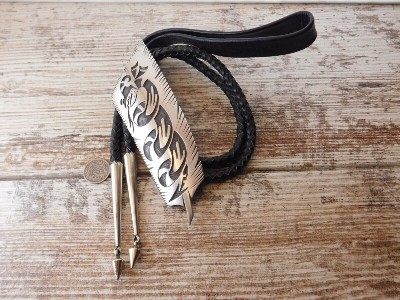Affiliate Disclaimer: We work to provide bolo ties and locate merchants who sell the products you are looking for. If you make a purchase from any of the merchants we endorse, we will earn a small commission at no additional cost to you. Thank you for your support!
What is Old Pawn Indian Jewelry and the Allure of Native American Jewelry
 When it comes to collectible Native American jewelry, the term "old pawn" signifies important ties to indigenous culture and lasting value. In particular, old pawn vintage turquoise bolo ties hold a distinct, cherished place in Southwestern artistic heritage spanning from early 20th century artists back through recent decades.
When it comes to collectible Native American jewelry, the term "old pawn" signifies important ties to indigenous culture and lasting value. In particular, old pawn vintage turquoise bolo ties hold a distinct, cherished place in Southwestern artistic heritage spanning from early 20th century artists back through recent decades.Defining Old Pawn
Old pawn refers to silver and turquoise jewelry pieces that tribal members originally pawned during challenging economic times in the early-to-mid 1900s. Skilled Navajo, Zuni, Hopi and other silversmiths would visit trading posts to exchange handcrafted necklaces, bracelets, and ornate bolo ties for vital cash and goods to aid their communities.
At trading shops like the famed John Lee and C.G. Wallace establishments, these exquisitely crafted ties and other jewelry would sit idly for months or years gathering infamous "pawn dust", until traders could finally sell them to outside collectors. Now, those same pawned ties reemerge as glorious relics etched with the patina of time. Their pawn tickets serve as artifacts that contribute to distinct old world appeal.
Complex Beauty and Variety
Beyond sheer age and nostalgia, the painstaking artistry of old pawn turquoise bolos also boosts allure for enthusiasts. Signature hallmarks denote families like the Begay, Quandelacy, and Tsosie who etched their silverwork with intricate beadwork, geometric stamping, and overlaying that remains impossible to perfectly replicate today. Distinct turquoise stones ranging from glowing green Variscite to brilliant blue Spiderweb add signature fingerprints. And Zuni, Hopi and Navajo cultural symbols link bolos directly to tribe history through traditional corn, kachina, and feather motifs.
No two vintage pawned pieces are ever exactly alike - adding excitement to the hunt for collectors seeking one-of-a-kind rarities. This makes acquiring museum-grade tie with certificate of authenticity a privilege. Their outstanding durability and uniquely Southwestern look retain deep appeal.
Preserving Cultural Heritage
Perhaps most compellingly, early old pawn turquoise jewelry allows new stewards to responsibly maintain important Native relics along with part of that cultural lineage. By archiving and displaying old pawn turquoise bolo ties that feature time-honored silver techniques and ancestral patterns, collectors prevent a vibrant artistic tradition from ever being lost. This honors Southwestern artists who fueled resurgence despite facing hardship. Above investing in precious materials, appreciating finely honed craft also pays respect.
While myriad stunning silver and turquoise examples populate trading posts today, the old pawn term remains highly selective. It applies only to authenticated resurfaced items like bolo ties with fading 1940s pawn backings, marking nearly a century since tribal artisans first etched their hopes into silver and stone. Donning old pawn turquoise connects wearers to the long memory of the earth itself. These distinguished "pawn alumni" endure as keepsakes that reveal the frontier spirit of yesterday while inspiring Native talent now looking to tomorrow.

Old Pawn Indian Jewelry & Bolo Ties
References
Hopi Tribe Official WebsiteHopi Cultural Center
Indian Pueblo Cultural Center - Hopi
National Park Service - Hopi History and Culture
Smithsonian Magazine - Hopi Tribe Overview





